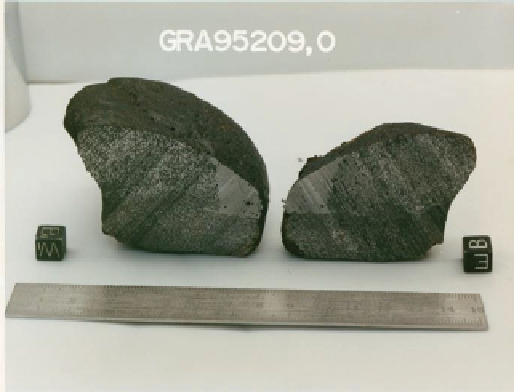Geology Reference
In-Depth Information
Lodranite
948.8 g
Found January 31, 1996
10.5 × 8.0 × 5.0 cm
Weathering = B
isotopic composition with acapulcoites and are believed to have origi-
nated on a common parent body. Lodranites experienced melting and loss
of the silicate component, with peak temperatures of ~1250°C. They pro-
vide our best glimpse of the early melting history of asteroids.
Plate 41
MiNERALogy
SigNiFiCANCE
gRA 95209 is an equigranular aggregate (grains
averaging 0.3 mm) of subequal amounts of nickel-iron,
olivine (Fa
7
), and pyroxene (Wo
3
Fs
7
), with minor plagio-
clase (An
19
) and clinopyroxene, (Wo
41
Fs
5
). The mixed
metal-silicate-sulfide matrix is cut by metal-rich, graph-
ite-bearing veins exceeding 1 cm in width and grades into
a volumetrically minor metal-poor region. Silicate com-
positions and modal abundances are typical for lodran-
ites, while the mineralogy of the metal-sulfide component
is complex and differs among the three lithologies.
gRA 95209 is the largest and, by far, exhibits the greatest
lithologic diversity among the acapulcoites and lodran-
ites. At almost 1 kg in mass, it exhibits metal-sulfide-
phosphate veins that formed during the earliest partial
melting of an asteroid (left, [275]). The pairings of phos-
phates and phosphides, Ni-rich and Ni-poor metal, and
graphite suggest that oxidation-reduction reactions
accompanied partial melting, testifying to the complex
chemical and physical processes occurring during the
earliest stages of differentiation of an asteroid.
References [270-277]




